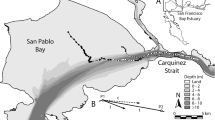Summary
-
1.
Oxygen consumption, undulation frequency, and tether force as an index to power output were measured in tethered, swimming marine iguanas.
-
2.
Power output increased linearly with total oxygen consumption and mass-specific oxygen consumption increased linearly with undulation frequency (Figs. 1 and 2).
-
3.
Velocity of free swimming iguanas is a linear function of undulation frequency and of total length (Fig. 3), which allows calculation of the equivalent velocity for tethered iguanas undulating in place on a tether.
-
4.
Cost of transport for swimming iguanas decreases as body mass increases, and can be predicted from the equation ml O2/kg·m=0.31M −0.56, whereM is mass in kg (Fig. 4).
-
5.
The change in cost of transport with body mass correlates with foraging patterns of different size classes of marine iguanas. Small marine iguanas feed on algae on or near shore while adults obtain algae by swimming offshore and diving.
-
6.
Cost of transport during swimming in marine iguanas is higher than for fish and turtles but lower than for ducks or humans (Fig. 5).
Similar content being viewed by others
Abbreviations
- \(\dot V_{O_2 } \) :
-
rate of oxygen consumption
- E t :
-
cost of transport in ml O2/kg·h
References
Bartholomew GA (1966) A field study of temperature relations in the Galapagos marine iguana. Copeia 1966:241–250
Bartholomew GA, Bennett AF, Dawson WR (1976) Swimming, diving, and lactate production of the marine iguanaAmblyrhynchus cristatus. Copeia 1976:709–720
Bartholomew GA, Lasiewski RC (1965) Heating and cooling rates, heart rate, and simulated diving in the Galapagos marine iguana. Comp Biochem Physiol 16:573–582
Bartholomew GA, Vleck D (1979) The relation of oxygen consumption to body size and to heating and cooling in the Galapagos marine iguana,Amblyrhynchus cristatus. J Comp Physiol 132:285–288
Bennett AF, Dawson WR, Bartholomew GA (1975) Effects of activity and temperature on areobic and anaerobic metabolism in the Galapagos marine iguana. J Comp Physiol 100:317–329
Brett JR (1965) The swimming energetics of salmon. Sci Am 213: 80–85
Calder WA (1974) Consequences of body size for avian energetics. In: Paynter RA Jr (ed) Avian energetics. Nuttal Ornithological Club Cambridge, Mass, pp 86–144
DiPrampero PE, Pendergast DR, Wilson DW, Rennie DW (1974) Energetics of swimming in man. J Appl Physiol 37:1–5
Fedak MA, Pinshow B, Schmidt-Nielsen K (1974) Energy cost of bipedal running. Am J Physiol 227:1038–1044
Gleeson TT (1979) Foraging and transport costs in the Galapagos marine iguana,Amblyrhynchus cristatus. Physiol Zool 52:549–557
Gleeson TT (1980a) Lactic acid production during field activity in the Galapagos marine iguana,Amblyrhynchus cristatus. Physiol Zool 53:157–162
Gleeson TT (1980b) Metabolic recovery from exhaustive activity by a large lizard. J Appl Physiol 48:689–694
Morgareidge KR, White FN (1969) Cutaneous vascular changes during heating and cooling in the Galapagos marine iguana. Nature (London) 223:587–591
Prange HD (1976) Energetics of swimming of a sea turtle. J Exp Biol 64:1–12
Prange HD, Schmidt-Nielsen K (1970) The metabolic cost of swimming in ducks. J. Exp Biol 53:763–777
Schmidt-Nielsen K (1972) Locomotion: energy cost of swimming, flying, and running. Science 177:222–228
Taylor CR, Schmidt-Nielsen K, Raab JL (1970) Scaling of energetic cost of running to body size in animals. Am J Physiol 219:1104–1107
Tucker VA (1970) Energetic cost of locomotion in animals. Comp Biochem Physiol 34:841–846
Tucker VA (1973) Aerial and terrestrial locomotion: a comparison of energetics. In: Bolis L, Schmidt-Nielsen K, Maddrell SHP (eds) Comparative physiology: locomotion, respiration, transport and blood. North-Holland, Amsterdam, pp 63–76
Webb PW (1975) Hydrodynamics and energetics of fish propulsion. Bull Fish Res Board Can 190:1–158
White FN (1973) Temperature and the Galapagos marine iguanainsights into reptilian thermoregulation. Comp Biochem Physiol 45A:503–513
Withers PC (1977) Measurements of\(\dot V_{O_2 } \),\(\dot V_{CO_2 } \), and evaporative water loss with a flow-through mask. J Appl Physiol 42:120–123
Author information
Authors and Affiliations
Rights and permissions
About this article
Cite this article
Vleck, D., Gleeson, T.T. & Bartholomew, G.A. Oxygen consumption during swimming in galapagos marine iguanas and its ecological correlates. J Comp Physiol B 141, 531–536 (1981). https://doi.org/10.1007/BF01101476
Accepted:
Issue Date:
DOI: https://doi.org/10.1007/BF01101476




